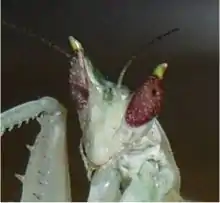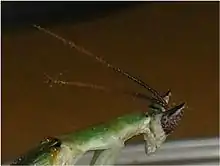Pseudoharpax virescens
Pseudoharpax virescens, common name Gambian spotted-eye flower mantis, is a species of praying mantis native to western, central and eastern Africa. It takes its name from two eye spots on the dorsal side of the abdomen of adult females.
| Gambian spotted-eye flower mantis | |
|---|---|
 | |
| Adult female Pseudoharpax virescens on a finger | |
| Scientific classification | |
| Kingdom: | Animalia |
| Phylum: | Arthropoda |
| Class: | Insecta |
| Order: | Mantodea |
| Family: | Galinthiadidae |
| Genus: | Pseudoharpax |
| Species: | P. virescens |
| Binomial name | |
| Pseudoharpax virescens Serville, 1839 | |
| Subspecies | |
|
See text | |
Description


Pseudoharpax virescens mimic flowers. They are mostly white with green wings and have pointy eyes. Pseudoharpax virescens are small for a mantis, around 3 centimeters in length as adults. 1st instar nymphs are almost 4 millimeters in length. The color of Pseudoharpax virescens eyes change night to day. At night their eyes are dark red, during the day their eyes are light green. Oothecae can be 5 millimeters to 15 millimeters long.
Sexual dimorphism
Females are usually about 28 millimeters in length, while males are usually about 25 millimeters. Females have short antennae, while males have long and red antennae. Females are bulkier than males. Eight segments can be counted on the underside of the abdomen of a male and six on that of the female.[1] Females have two dots on their abdomens as adults, while males, whose abdomens are thin and covered completely by their wings when looked at from above, appear to have none.


Subspecies
There are two subspecies in this species.
- P. v. centralis (La Greca, 1954) - found in central and eastern Africa
- P. v. virescens (Serville, 1839) - found in western and central Africa
Captivity
These praying mantises are kept and bred in the pet mantis hobby. They are relatively tolerant of different temperatures and humidity levels, a temperature of about 100 degrees Fahrenheit being suitable for these insects.
This mantis breeds rapidly, with females able to lay an ootheca every 3 to 4 days at high temperature.
Pseudoharpax virescens can live together without much cannibalism or maybe none when a reliable food source is present. They are very fast and skittish when they are young nymph, but when they get older, they are rather calm. Adult males are skittish and are strong fliers. Pseudoharpax virescens sway sideways in the wind to imitate foliage and they move their antennae back and forth very fast while moving around. They are aggressive predators, with adult females willing to tackle prey as large as themselves. Males are more timid so they need smaller prey items than females will take.
References
| Wikimedia Commons has media related to Pseudoharpax virescens. |
